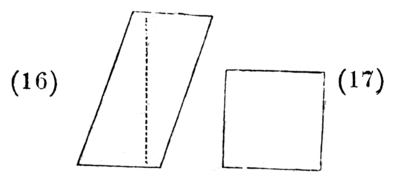7
right hand lower angles are as far apart as the other two angles are. Figure 14 is what is often called a long or oblong square.
29.Make a rectangle, and cut it into equal right angles. fig. 15.

30. Make a parallelogram, and mark its height. (fig. 16.)
The parallelogram, like the rectangle, has its opposite sides parallel, but none of its angles are right. The height is a perpendicular dropped from the top to the base, and is marked by the dotted line in the figure.
31. Make a square. (fig. 17.) This figure has all its sides equal, and all its angles right.

32. Draw two angles with parallel sides. (figs. 18 and 19.)
Two angles, as in figure 18, are called parallel, not because their sides are of equal length, but because their openings and points correspond exactly. Fig. 19 is designed to exercise the pupil in making parallel angles in various positions.
